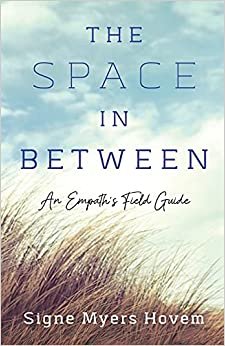by Signe Myers Hovem
One of the blurbs offered for my book The Space in Between: An Empath’s Field Guide generously states that I “put words to the wordless,” which honestly, was the most gratifying praise I could have received. It also partly explains why it took me so long to write my book—nearly ten years of countless revisions, exploring how to articulate my intuitive sensory existence.
For many empathic persons the world can be confusing and isolating; particularly for those who are unaware that they receive extrasensory information from the environment and unwittingly accept what they feel as their own. Or for those who are aware that they are empathic, yet feel a disconnect due to a lack of definition and understanding of what that means within society. Most dictionaries, in fact, place the origin of “empath” in science fiction and fantasy, which hints at the difficulties people with such sensitivities and abilities face in communicating how they experience the world.
How do you validate your sensory experiences of feeling emotions, thoughts, and physical discomfort of others when even the dictionary—the authority on language—only affords you an existence in science fiction or fantasy?
The effort of giving language, and thus form, to the nebulous-yet-visceral experiences of an empath undeniably challenged me. My intention throughout my writing process was to demystify the empathic experience for anyone, empath or not, and that meant I needed a way to let the reader into my world. The irony is not lost on me that “world building” is typically a task for fantasy and science fiction writers and not one for a nonfiction writer describing the physical world we all inhabit in the here and now.
And there’s the rub; empathic or not, we don’t all inhabit the same view or perception of the world. Once I recognized that the dictionary’s definition of an empath revealed more about the collective mainstream beliefs and biases than what an empath was, beyond labeling it a paranormal ability, my book’s structure emerged, as did my sense of purpose. I would be a guide to the reader, supported by ancient Greek poet Pindar’s prompt, which has been my personal touchstone and is quoted in the early pages of my book: “Learn who you are and be such.”
How do we, as individuals, learn who we are? From an early age we are told who we are, or who we should be, by our family and our society. Though this telling may be more about safeguards than outright intentional suppression, this standardized approach to life influences the collective perception of what’s true and possible within human experience. Any person who envisions or experiences a contrary reality to the mainstream version will undoubtedly be pushed to question personal truths. At the very least, they will be challenged to be authentic in a world of conformity.
Self-awareness and acceptance are pivotal mindsets that, once embodied, open life up to self-actualization and authenticity. For an empath, that journey involves an evolutionary arc from being an overly sensitive person trying to survive in their environment by feeling separate, to becoming an engaged and functional empath who witnesses what’s out of balance and honors that connection. Along this arc is gaining the understanding that the physical world is an energetic expression. Intuition’s wheelhouse is the ability to sense the energetic realm, which is how an empath can sense others’ displaced and unprocessed emotions, thoughts and physical discomfort.
Writing The Space in Between: An Empath’s Field Guide , I needed readers to grasp a unified sensory system that includes intuition—while removing the science fiction and fantasy bias. To build awareness of our relationship to the energetic world, I created field guides for five different landscapes: The Field of Reflection, The Field of Definition, The Field of Sensing, The Field of Experience and Awareness, and the Field of Mystery. Each of these fields provided me with insight and movement in my own journey toward a balanced perception of the world and my place in it as an empathic person, wired for extrasensory reception and connection.
I hope readers, empath or not, will embrace the inherent wisdom offered by an empathic nature: the fundamental truth that we are sensory, energetic, creative, and multi-dimensional beings; and we are all connected.
The Space in Between: An Empath’s Field Guide offers questions for reflection at the end of each chapter, inviting the reader to understand their own sensitivities, their own capacity to care for themselves and others, and to embrace the larger conversation their sensory nature holds with the world and humanity. I hope they feel seen, heard and witnessed as I name and define my experience as an empath.
Signe Myers Hovem is the author of The Space in Between: An Empath’s Field Guide . She has created homes on five continents over twenty years, raised four uniquely sensitive children, pursued a special education lawsuit appealed to the US Supreme Court, volunteered in a hospice in Texas and an orphanage in Azerbaijan, worked as a spiritual counselor in Houston Texas, and taught workshops and trainings in the art of being an empath and the power of language in many countries around the world. She splits her time between Boulder, Colorado, andOslo, Norway. For more information, please visit https://www.smhovem.com






